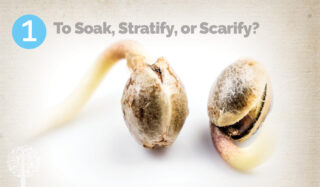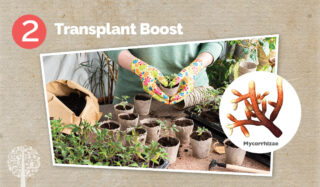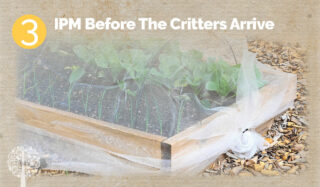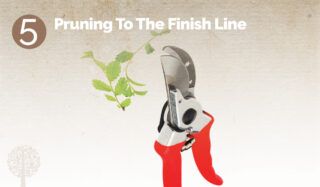5 Cool Ways To Support Plants Through The Growth Cycles
We all need a support system, and plants are no different! To get the best harvest yields, nurturing plants through all stages of growth is critical. There are countless ways you can offer your garden the best life possible; let’s get you started with our list of 5 Cool Ways To Support Plants Through The Growth Cycles.
To Soak, Stratify, or Scarify?

Not all seeds are created equal; some need extra attention before planting. For example, some wild seeds germinate best after stratification, exposing them to cold to imitate the dormant winter period they’d naturally experience if left outdoors. Others, such as peas and legumes, nasturtiums, and cannabis require scarification, which involves scratching the hard seed coat with sandpaper or something rough so moisture can enter and help the seed sprout. Finally, seed soaking is another tried and true method to jumpstart beans, squash, beets, and more. You can use either a moist paper towel or a water bowl. To determine the best plan for your seeds, carefully read the packets before starting.
Transplant Boost

After successful germination and a lot of TLC, your plant babies are ready for transplant. You can do many things to help your seedling through this next stage, including selecting the right container. Determine your plant’s size at maturity and select pots or spaces in the garden that can accommodate them and their expanding root zone. Rootbound plants will suffer and never reach their full potential. The secret ingredient to helping your plants grow strong and healthy? Mycorrhizae! Essential to the soil food web, plant roots adore this beneficial fungus. Applying a mycorrhizae product directly to the rootball or the planting hole will help reduce transplant shock. Other benefits include increased nutrient uptake, better pest and disease resistance, and higher yields. You can use granular mycorrhizae or a water-soluble product. Whatever option you choose, your precious transplants will thank you for the boost! Finally, foliar feeding is excellent in both the vegetative and flowering stages and allows nutrients to enter through the plant leaves and directly into the vascular system. You’ll notice the results within a few days; spray in the morning or early evening when the sun isn’t so intense.
IPM Before The Critters Arrive

You’ve nurtured your babies from seed, and now that they’re happily growing, you’re looking forward to making it to harvest. Unfortunately, a pest invasion can happen in the blink of an eye, dashing any dreams of a successful crop. Support your growing plants with Integrated Pest Management (IPM) before any destructive insects move into the garden. The first step is to monitor your garden daily. Take the time to walk through the rows and observe your plants, checking leaves, flowers, and fruit to be sure nothing is chomping away or getting ready to lay tons of eggs and take over. Place yellow sticky traps beside your plants to see what you’re dealing with before things snowball out of control. Floating row covers are another excellent option for pest management, as the lightweight mesh fabric will prevent unwanted bugs from landing on your crops. Consider pest-resistant plant varieties, and interplanting with trap crops will help deter predator bugs from what you are growing for yourself. Plant diversity will attract many insects, including beneficial ones that eat the bad guys. If growing indoors, consider releasing beneficial insects into your environment early.
Let There Be Fog

A fogger is a must-have for all indoor growers looking to support their plants through the vegetative cycle. This incredible tool helps plants thrive in dry locations by boosting humidity, something tomatoes, eggplants, and cannabis love. It also decreases VPD, which helps open the plant’s stomata. A well-balanced VPD means the crop can better respond to light and temperature in a controlled environment. Are you gardening outdoors? A foggy morning will work wonders for you, but you can keep the dreamy vibe alive by installing an outdoor fog system into your landscape design. The fog shoots look pretty and give a zen-like feel to your space, but more importantly, installing the systems close to tropical plants offers the perks associated with increased humidity.
Pruning To The Finish Line

Do not underestimate the power of pruning and cutting back plants! This process can be done throughout the vegetative and flowering cycles, although pruning during flowering should be limited. Always remove dead, diseased, or damaged material so your plant can focus on producing yields above anything else. Many gardens become unruly as plant growth kicks into high gear, and removing excessive foliage will help prevent disease and allow light to hit fruiting areas better. As a result, you’ll have robust plants and an even canopy with better yields. Speaking of yields, be sure to harvest on time so your plant can put its energy into producing new fruits. As for edible and ornamental perennial plants, cut them back after they’ve finished blooming so they can put their energy into growing stronger for the next growing season.
If you’re looking for a fun-to-read resource on growing plants from seed to harvest, check out The Vegetable Gardening Book: Your Complete Guide To Growing An Edible Organic Garden From Seed To Harvest, by Joe Lamp’l.



